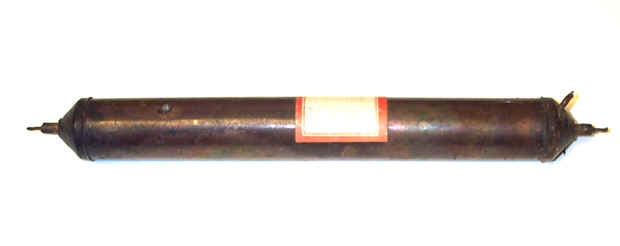GM Detector of Robert Millikan (ca. 1939)

Several hundred of these Geiger Mueller (GM) detectors were built in 1939 at the Caltech physics laboratory for use in cosmic ray studies. The above example is approximately 12 inches long and is made of copper. The paper label identifies three dates: August 2, 1947; January 25, 1948; and July 8, 1950. The 1947 date refers to balloon flights performed at different latitudes from Texas to Saskatoon. A typical flight would carry the instruments to 70,000 to 80,000 feet. The 1948 date refers to experiments performed in a B-29 bomber flying at 30,000 feet from Hudson Bay to Lima, Peru. Robert Millikan and Victor Neher were among the personnel on this flight.
Robert A. Millikan (1868-1950) was the most famous America Scientist of the 1920s, and the second American to receive the Nobel Prize in physics. The latter was awarded for his measurements of the charge on an electron (via the well-known "Millikan oil drop experiment") and for experimentally confirming Einstein's equations for the photoelectric effect. In 1921, Millikan left the University of Chicago to head up the newly created California Institute of Technology in Pasadena. At CalTech, he also served as Director of the Physics Department. His research there focused on the nature and origin of cosmic rays—Millikan coined the term "cosmic ray." These investigations helped demonstrate the extraterrestrial source of this radiation and its variation in intensity with latitude.
Donated by the California Institute of Technology courtesy of Bud Cowan.
